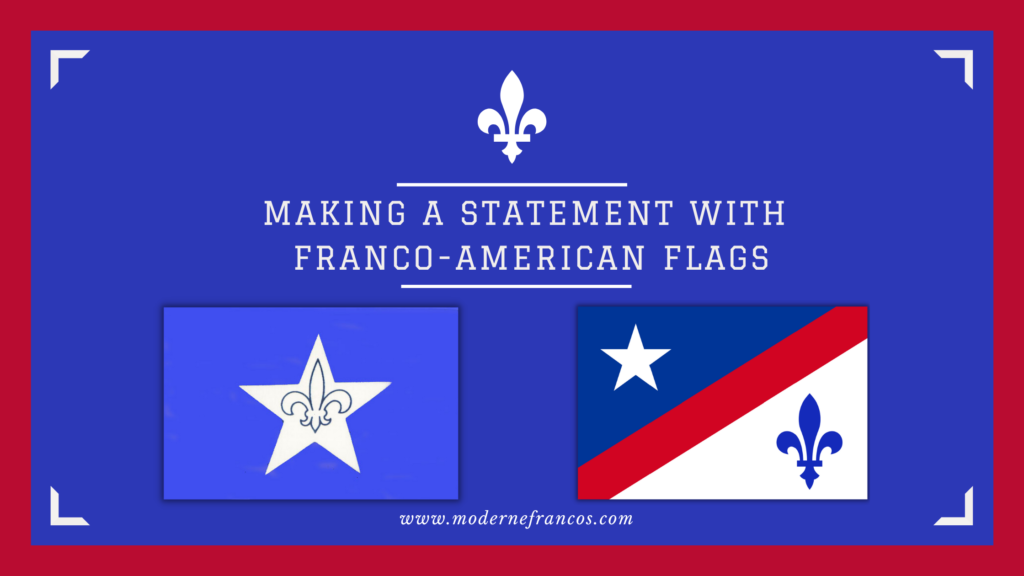
With many distinct ethnic cultures in the United States, a flag is uniquely designed and chosen by organizations or clubs of a heritage and culture to represent themselves. This is also the case for Franco-Americans, where we have several flags that represent us.
In fact, there are more flags out there than you might think. For now, we’ll cover our two national flags and the more specific flags representing other groups within our Northeast American French culture.
So what’s the story behind all of these flags? Let’s dig deeper, starting with the definition of “Franco-American,” for anyone who may be unfamiliar with the term.
“Franco-American” is described as “an American of French or especially French-Canadian descent.” I covered this topic in an older post, but here’s the gist:
If you are an American with any French-Canadian ancestry, you are considered a Franco-American. Some definitions include ancestry from France, but it’s usually a matter of opinion. Of course, it also comes down to referring to yourself as a Franco-American.
Now that we’re clear about who a Franco-American is, let’s cover the main flags of Franco-America, New England, and the Northeast.
The Franco-American Flag of New England, the Northeast, & the U.S.
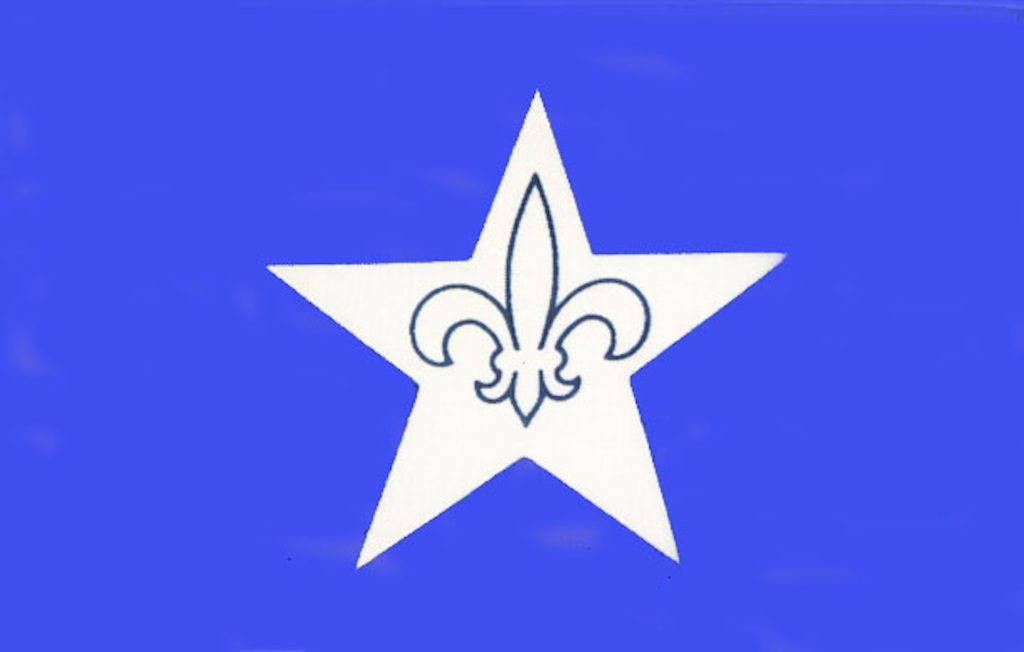
The Franco-American Flag of New England was designed by Robert L. Couturier, a one-time mayor of Lewiston, Maine, among other positions he held in the community. Couturier also produced radio broadcasts and wrote for Le Messager and L’Unité Franco-Américain.
On May 29, 1983, the flag was adopted by Franco-Americans at Saint Anselm College in Manchester, New Hampshire. Couturier’s flag design was also adopted by Franco-Americans throughout New England and New York. On August 5 of that year, the flag was adopted by the Assembly of Franco-Americans in Mackinac, Michigan.
Although intended to be used for Franco-Americans in the Northeast, it was approved by the Association of Franco-Americans to be the official Franco-American flag for all Americans of French descent.
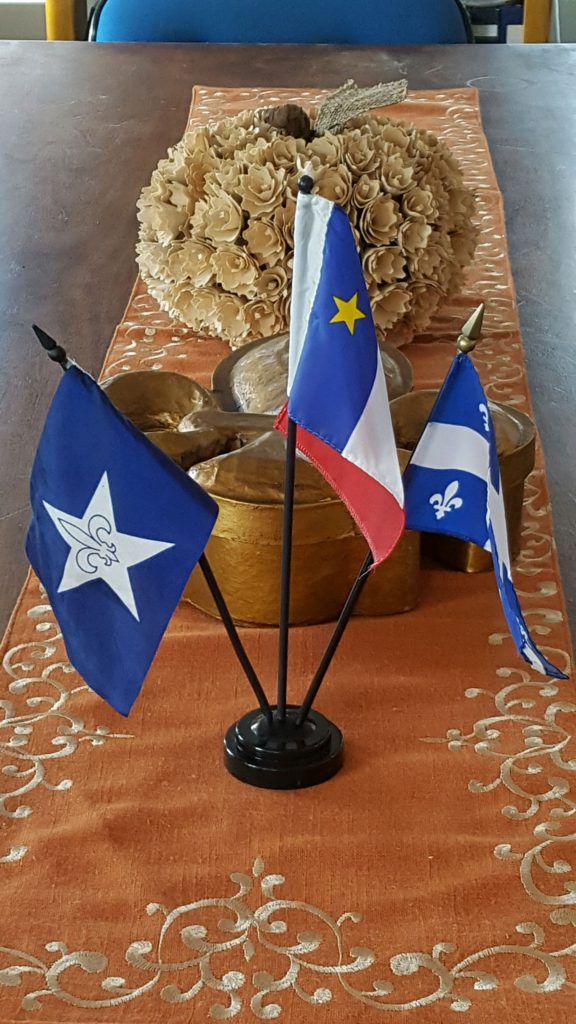
This Franco-American flag has been on the scene for a number of years. Online, it’s mostly referred to as the “Franco-American Flag of New England,” but further research has shown that it was officially adopted by other Franco-American organizations in the rest of the Northeast U.S., parts of the Midwest, and eventually approved to be the national flag.
The blue flag with the white fleur-de-lys within a white, five-pointed star each symbolizes unity between Québec, Acadia, and France. The blue and white are from the American flag, but can also represent the flags of Québec and France.
While the star represents the U.S., the fleur-de-lys stands for the distinct French heritage and cultures of Québec and France. It also symbolizes our heritage and culture as Franco-Americans.
This flag was also featured on the cover of “Franco-America in the Making: The Creole Nation Within” by Jonathan K. Gosnell. In the book, Gosnell documents the stories of Franco-Americans as he seeks out our identity and culture in New England.
The city of Lewiston, Maine flies this flag and it can be seen in Veteran’s Memorial Park. The Franco-American Programs on UMaine’s campus in Orono also officially uses this Franco-American flag.
You can find this Franco-American flag for purchase by clicking here.
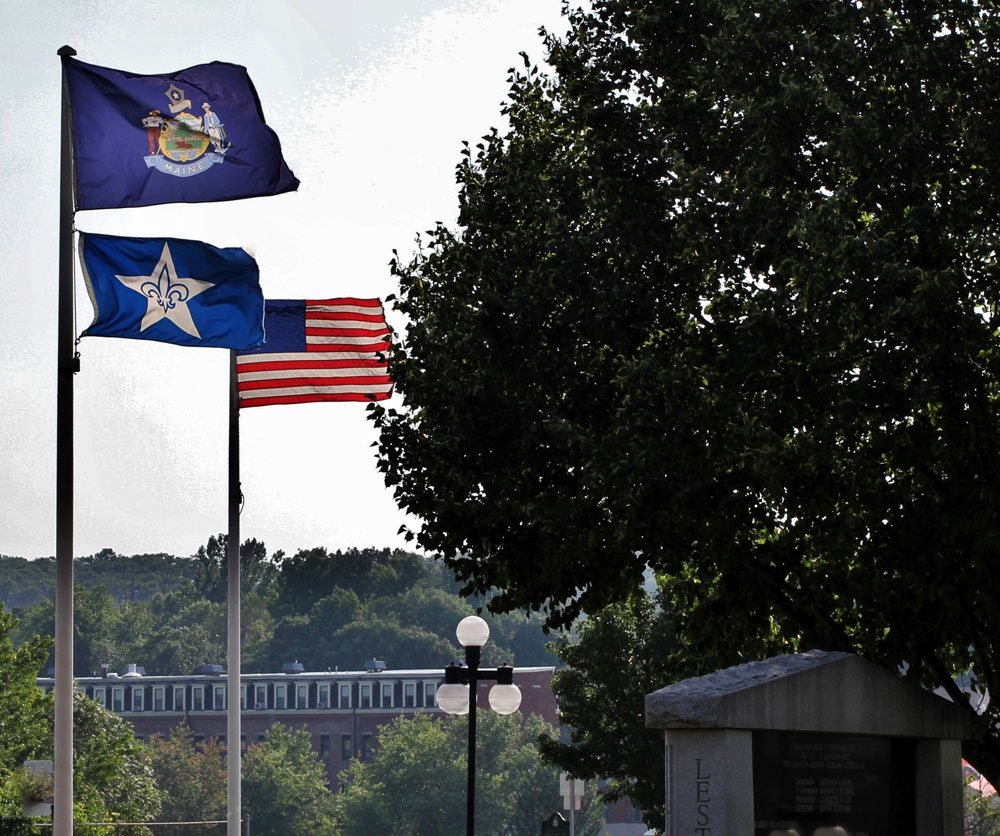
The Redesigned Franco-American Flag
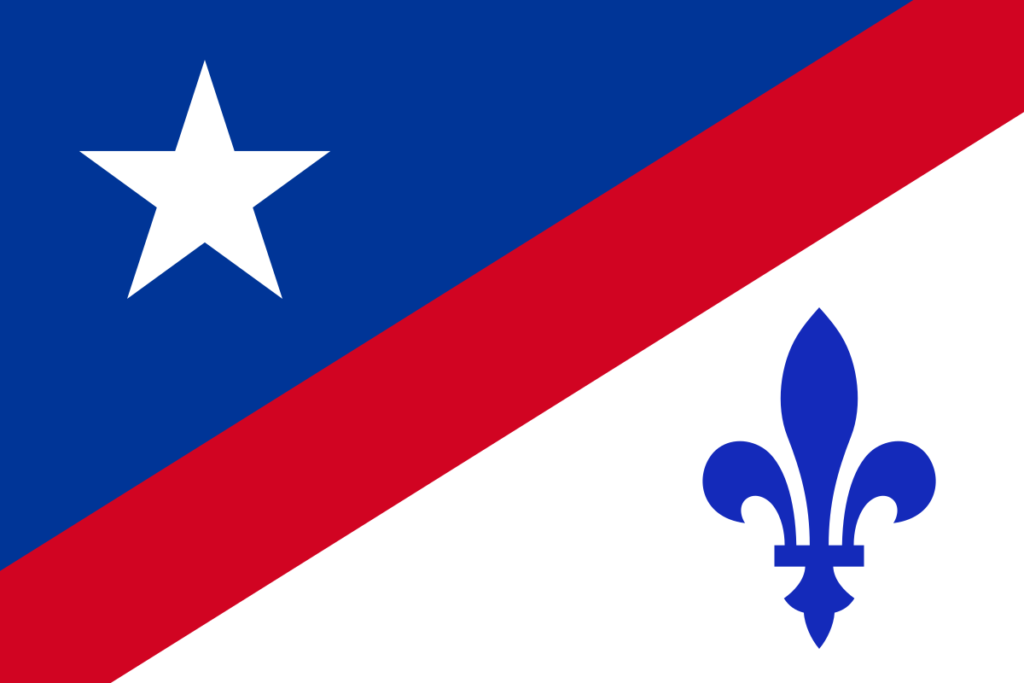
This Franco-American flag was created as a representation of us throughout the United States. It seems that it was created as a redesign of the previously designed Franco-American flag. The red, white, and blue reflects the tricolor of the American flag and the flag of France. Although, I would want the blue and white to also symbolize Québec because of the closer connection to the province that we have as Franco-Americans.
This redesign of the Franco-American flag is available for purchase here.
The white star on the top left of the flag symbolizes the unity of Franco-Americans throughout our country and our solidarity to the U.S. On the bottom right-hand corner, the design of the blue fleur-de-lys is the same as found on the flag of Québec. This solidifies our connection to the land our ancestors immigrated from, since this fleur-de-lys is unique to the province.
As stated in one of my older posts about the Franco-American flag, it is *claimed that this Franco-American flag was given to Édith Butler, a Canadian singer-songwriter of Acadian heritage. While performing for her concert tour on June 24, 1992 in Manchester, New Hampshire, she displayed the flag given to her by the Franco-American community of **NH, Vermont, Massachusetts, and Upstate New York.
*This claim is stated here, where it appears to be archived posts from a forum. One user confirms the claim that Édith Butler presented a Franco-American flag. Since the posts were made in 2010, calling this Franco-American flag a "proposed flag," it's safe to assume that I had incorrect information in my older post, "What You Didn't Know About the Franco-American Flag." I was under the impression that this FA flag was the one Butler was given in 1992. She was likely given the Franco-American flag created by Robert Couturier in 1983, although the posts on the forum are not clear about that either. **In my previous post, "What You Didn't Know About the Franco-American Flag", I wrote that the Franco-American flag was given to Édith Butler by the Franco-American community of Upstate New York and New York City. Update: in my research for this new post, I found that a Franco-American flag was given to Butler by the Franco-American community of Upstate New York and New Hampshire, Vermont, and Massachusetts.
It is unclear who designed this Franco-American flag and it appears to be a creation of several different people collaborating online, but no specific names seem to be attached to the design. This Franco-American flag has had many alterations, as seen by this older version below.
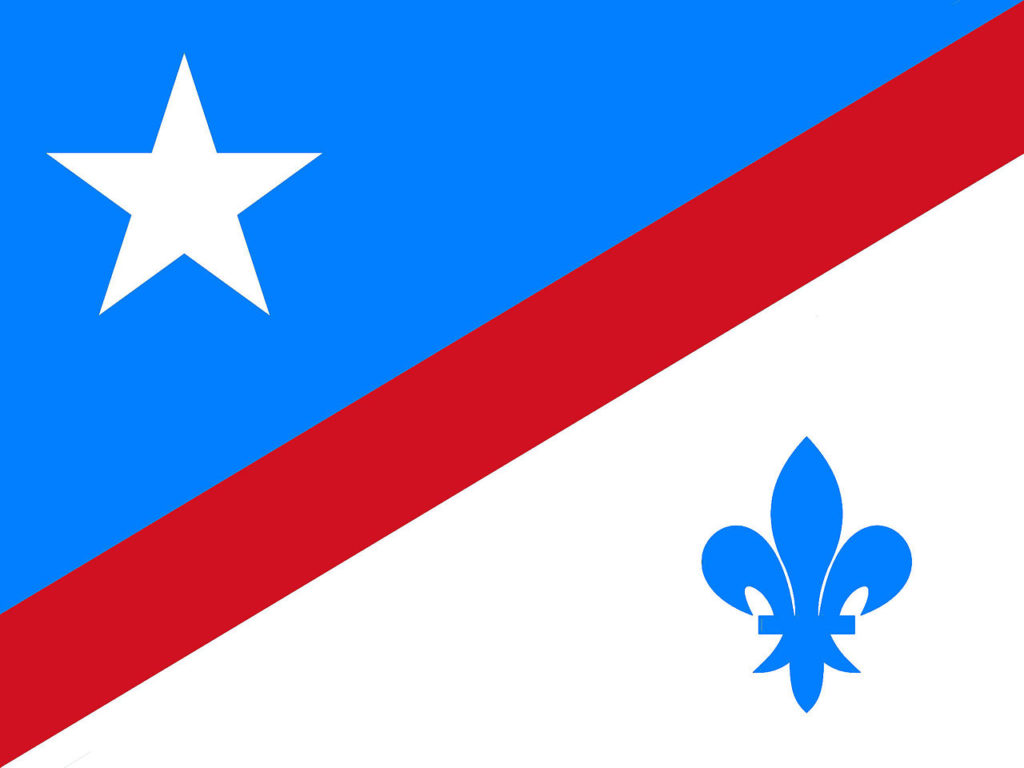
Although this flag hasn’t been officially recognized, it’s been placed as the flag for “les portail des Franco-Américains” on Wikipedia Portals. The site is not always known as the best source, but it’s clear that this was a collaboration project between Francophones to recreate the flag and document the history and culture of Franco-Americans.
The Acadian Flag & Its New England Versions
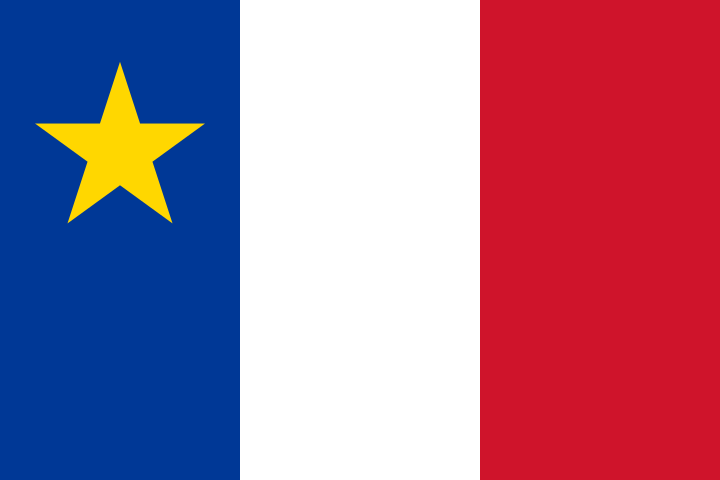
Representing the Acadian population, this tricolor flag mirrors the French flag but with an added yellow star. The Flag of Acadia was adopted on August 15, 1884 during the second Acadian National Convention held in Miscouche, Prince Edward Island. About 5,000 delegates of Acadian heritage from the Maritime Provinces attended the convention.
Acadians typically don’t put themselves into the “double melting pot” of Franco-Americanism, as they are a distinct group outside of our French-Canadian ancestors. But I wanted to include their flag and flag variations in this post to acknowledge that they have a distinct flag that represents them as a whole as well as flag variations found in New England. The crucial symbol to take notice of is the yellow star on Acadian flags and not the fleur-de-lys, which is a uniquely French-Canadian symbol.
The creator of the Acadian flag, Father Marcel-Francois Richard, was a priest from Saint-Louis-de-Kent, New Brunswick. He chose the red, white, and blue tricolor to reflect the French flag. He believed that the color blue also represented Roman Catholicism.
As Father Richard described it, the blue in the flag is “the distinctive emblem of our Acadian nationality.” Specifically, blue symbolizes the star of the Patron of the Acadians, the Blessed Virgin of the Assumption.
The yellow star was chosen because it’s the color that represents the Pope. Choosing yellow was a way to solidify the connection to the Roman Catholic church in the history of the Acadians.
But the star itself stands for the Stella Maris, which is also the symbol of Mary.
“It has been proposed by the Secretary and seconded by Reverend M.-F. Richard that: The tricoloured flag be the national flag of the French Acadians. As a distinctive mark of the Acadian nationality, a star, representing Mary, will be placed in the blue section of the flag, which is the symbolic colour of the people who are devoted to the Virgin Mary. This star, Stella Maris, that must guide the small Acadian colony through storms and pitfalls, will be yellow in order to show our sacred attachment to our mother, the Holy Church.” – Father A-D Cormier
There does seem to be folklore surrounding the Acadian star with the claim that it symbolizes a starfish. It’s been said that the marine animal guides sailors “through storms and reefs.”
Father Richard said this about his choice of the tricolor with the addition of the yellow star:
“I wish that Acadia had a flag reminding not only that its children are French, but also that they are Acadians.”
The creation of the flag was a major part of the Acadian Renaissance. Its design and symbolism emulated their harsh history but victorious story.
The Acadian flag is available for purchase by clicking here.
The Flag of the Saint John Valley

Within Maine, there are Franco-American communities with their own area’s flags. Two of those distinct communities are the Saint John River Valley and the city of Lewiston, as well as other areas throughout Central Maine.
In the Saint John River Valley, also referred to as “The Valley,” the majority of the community’s residents have Acadian heritage. They proudly fly the tricolor flag with the yellow star that represents Acadians as a whole.
There’s another tricolor flag for The Valley that features a green pine tree, white fleur-de-lys, and yellow star. Although the fleur-de-lys doesn’t typically represent Acadian heritage, it appears on the flag to represent the French heritage of the region.
In this video clip, the Flag of the Saint John Valley is seen on a sign in this news report, “Franco-Americans strive to keep the French language alive in Maine.”
The report takes us to The Valley and talks about the effects of the ‘No French’ law passed in 1919. This law is believed to have “contributed to the diminishing of a once-thriving French language in northern Maine.” For a rebuttal to this report by News Center Maine, check out Historian Patrick Lacroix’s post, Hauntingly Silent: Some Questions Concerning Maine’s English Education Bill, on his blog, Query the Past.
This flag is not available at the moment, but I am looking for a seller and will update this section if I find this flag for sale.
The Flag of New England Acadians
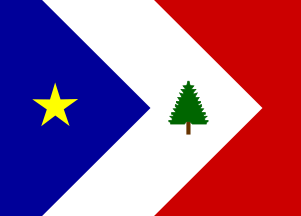
Another tricolor flag featuring the green pine tree is the flag of the New England Acadians. We know that the yellow star on this flag and The Valley flag above come from the Acadian flag. We also know that the fleur-de-lys on The Valley flag represents the French heritage of the region. But what does the pine tree on The Valley flag and this flag for New England Acadians represent?
The creator of the New England Acadian flag, William J. Cork, explained in a blog post that he was inspired by the Flag of New England adopted in the 17th century. It’s mostly red with a small white square in the upper left-hand corner with the green pine tree. Specifically, the Eastern white pine which is the most prominent tree found throughout the region.
More insight about the New England Acadian flag from the blogger:
“My design for a New England Acadian flag combines the Acadian flag with the 17th/18th-century flag of New England…The New England Acadians who saw me wearing it at Grand-Pré on August 13 [2004] were quite enthusiastic. Before a talk by Lucie LeBlanc Consentino on our New England Acadian Heritage we convened an impromptu Society of New England Acadians and officially adopted it.”
The New England Acadian flag is available for purchase here.
The St. John the Baptist Union Flag
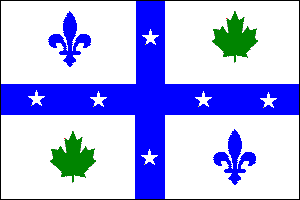
As for the Lewiston, Maine area, a city rich with Franco-American history, you might see the St. John the Baptist Union flag flying around. Named after a Franco-American organization, and of course, Saint John the Baptist, this flag is white with two blue stripes laying vertically and horizontally. Within the stripes are six white stars that represent the six states of New England. It also has two blue fleur-de-lys and two green maple leaves, which stand for French heritage and their connection to Canada.
The flag was created by Brother Gerard Brassard, an author of a book about the heraldry of the Roman Catholic Church in America. The St. John the Baptist Union flag first appeared in June 1978. It was carried by Franco-American pilgrims going to France. St. John the Baptist Union was founded in Woonsocket, Rhode Island in 1900.
This flag is not available at the moment, but I am looking for a seller and will update this section if I find this flag for sale.
Connecting With Franco-American Flags & Making a Statement
Now that we have this collection of Franco-American flags that represent us as a cultural group in the United States, specifically in New England and the Northeast, which flag do you feel a connection with?
Since researching my Franco-American background in my adolescent years, I remember finding the redesigned Franco-American flag particularly striking. It was also the first time I found a piece of Franco-American culture that represented us as a unified group. I never imagined at the time that we would have a flag of any kind, so finding this flag in my online research made me wonder if there could be a community out there proudly waving it.

It’s my personal favorite out of all the Franco-American flags for the blue and white with the bold red stripe in the middle bringing together the elements of the star and fleur-de-lys.
But there is a question concerning this redesigned flag and the Franco-American flag created in 1983.

Which of the two Franco-American flags should represent all of us?
I believe both can be fantastic representations of our heritage and culture. They each catch the eye in different ways and have a story of their own behind the symbolism of the fleur-de-lys and star. They were both created out of the passion to keep our culture relevant in the present and alive for future generations.
No matter which flag in this list we believe most accurately represents us, our flags are mostly known to only us.
When we display our flags in any way, whether it’s flying a flag at our home or sharing an image through social media, there are bound to be questions about what our chosen flag means. This opens the door to discussion and discovery of Franco-American heritage and culture.
Because we aren’t a well-known group, I’ve thought of Franco-Americans as an underground club. Telling someone about our heritage and having them respond with “Oh, I’m also Franco-American!” is like a secret handshake to us.
More than anything, these flags bring us together as Franco-Americans. When there are already several flags that have been created and displayed for years, it would be challenging to narrow it down to one main flag to represent all of us.
But when we see any of these flags in New England or the Northeast, we’ll know what they mean and why they’re displayed. We’ll know that we’re among others who understand our culture and can relate to us, even if we have had different individual experiences.
Being Franco-American brings us together in learning our history and sharing stories of our upbringing. Prior to being involved in this scene, I thought that I was passionate about my interests. But nothing has made me feel more of a sense of belonging than this community.
Having visuals of our heritage connects us to each other and solidifies our culture in our surroundings. Catching a glimpse of a fleur-de-lys or a Franco-American flag becomes a firm statement proclaiming, “We’re still here.”
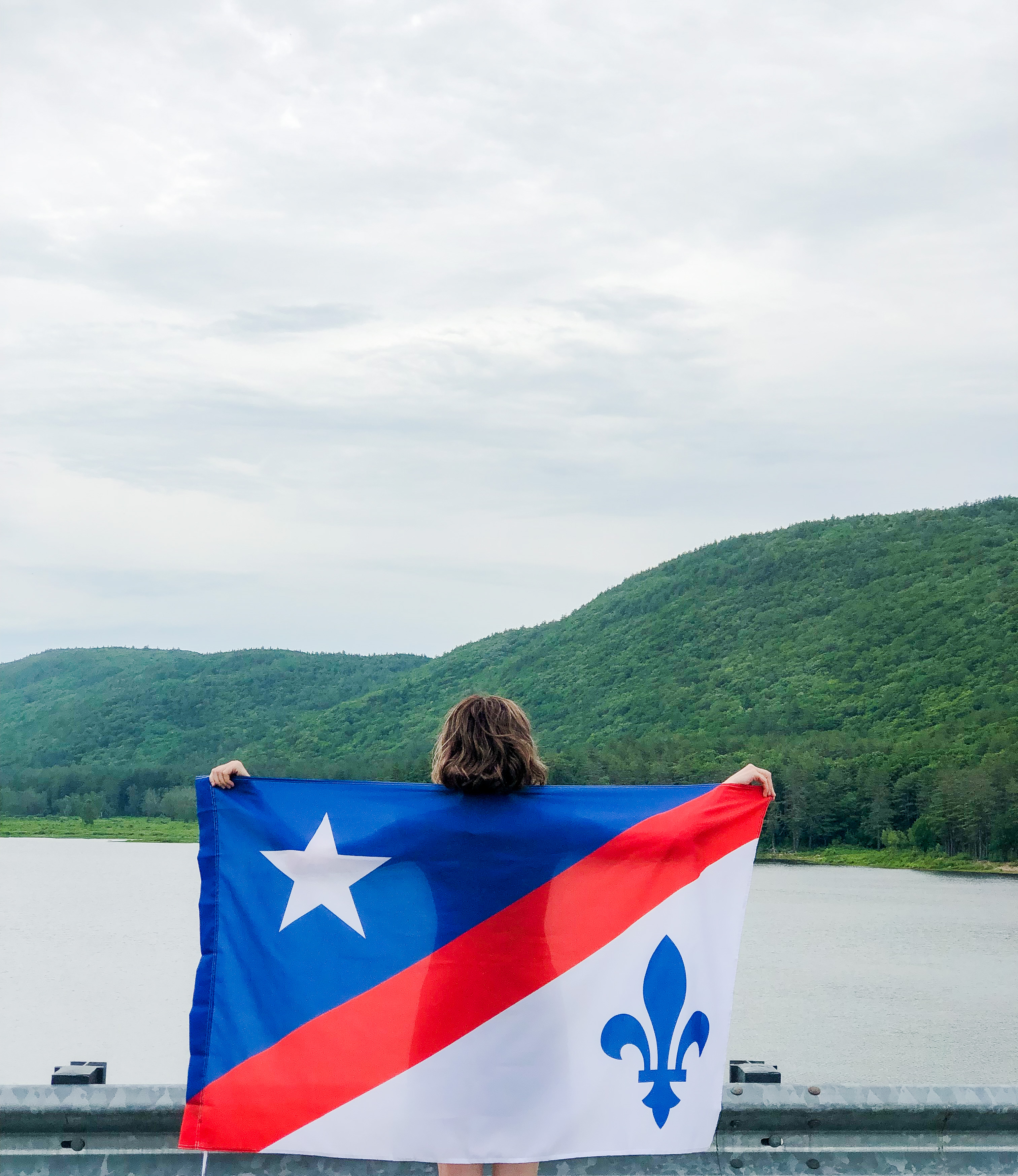
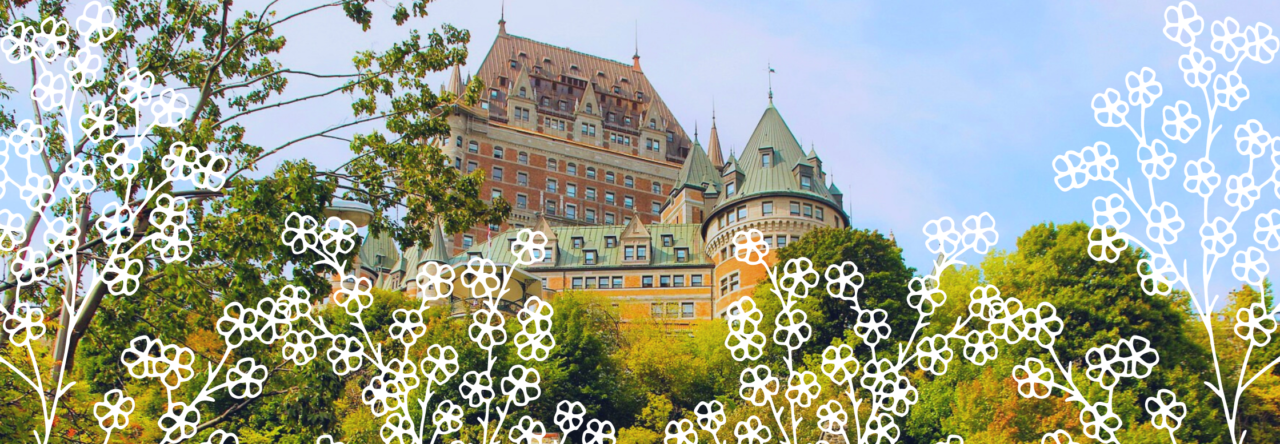
Keith
Would be nice if the article provided web sites to find these flags for purchase
Josue Savoie
I would have liked to have seen the flag of the Midwest Franco-Americans included! It’s three gold Fleur Des Lys on a blue background adopted in 1984!